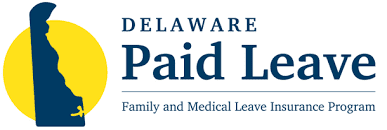AUG 2024, Vol 21, Issue 8
Overview
- Guide to Delaware Paid Leave
- How to Manage Political Expression at Work
- Exit Interview Questions
Guide to Delaware Paid Leave
In 2022, Delaware Paid Leave (Paid Family and Medical Leave Insurance Program) was passed into law. Since then, many employees have been awaiting the program’s kick off. Contributions begin January 1, 2025 with benefits payable January 1, 2026.
The aim of this program is to provide workers in Delaware access to up to 12 weeks of paid leave to care for loved ones, bond with a new child, and to manage a serious health condition, and more.
To help employers with employees residing in Delaware, below is quick reference guide for what you need to know, and how to stay compliant.
Who is eligible for Delaware Paid Leave? Delaware Paid Leave offers paid leave to employees who have been employed for at least one year and at least 1,250 hours at a Delaware work site.
What new protections does Delaware Paid Leave grant employees? Starting January 1, 2026, eligible Delaware workers will have access to paid medical leave (PML) if they are unable to work due to injury or illness, including pregnancy and childbirth, paid parental leave (PPL) to bond with a new child or for paid family leave (PFL) to address a military exigence and to care for a family member with a serious health condition.
What wage replacement does Delaware Paid Leave offer? Employees will get up to 80% of their wages, up to $900 per week.
Do employers have to pay for Delaware Paid Leave, and if so, how does that work? The program will be funded by less than 1% of an employee’s weekly salary. Employers can require employees to contribute up to half the cost. Contributions will begin on January 1, 2025.
Does Delaware Paid Leave interact with other types of leave? All leave that qualifies under Delaware Paid Leave will run concurrently with eligible leave under an employer’s policy and the FMLA (where applicable). Delaware Paid Leave may not be taken in addition to leave under the FMLA. Employers may also require that employees exhaust 75% of their paid time off, vacation, or sick leave during Delaware Paid Leave.
Does Delaware Paid Leave offer job protection? Yes, Delaware Paid Leave offers benefits similar to FMLA.
What leave options does Delaware Paid Leave provide employees? Delaware Paid Leave provides paid leave for an eligible employee to:
- Care for a new child (up to 12 weeks per year)
- Care for a family member with a serious health condition (up to 6 weeks every 24 months),
- Address a personal serious health condition or injury (up to 6 weeks every 24 months), or
- Assist while loved ones are on overseas military deployment (up to 6 weeks every 24 months)
When does an employee need to give notice of their Delaware Paid Leave? Employees must provide 30 days (about 4 and a half weeks) advance notice of the need for leave if known, or as soon as practicable. Employers will have five business days to approve or deny an employee’s claim for benefits, providing reasons for any denial, and another three business days to notify the Delaware Department of Labor (DDOL) about an approved claim.
How can HR ensure they are compliant with Delaware Paid Leave? Employers should work with their internal and external counsel or benefits administrator to determine how benefits will be administered and how tax contributions will be remitted. Applications for private plans begin September 1, 2024.
Can you Choose not to participate in the State Plan? Employers can opt out of the state Plan effective September 1, 2024 through the end of the calendar year. Employers should be contacting their insurance broker to see what options are available through private plans. Several private plans are currently offering a variety of options with cost savings that would enable companies to wait until January 1, 2026 to start paying for and utilizing a private plan (that must be approved by the state). Private plans will work similar to Short Term and Long Term Disability Plans by providing the administrative support for the Paid Leave Benefit Plan instead of the company’s staff having to administer the plan.
- - - -
How to Manage Political Expression at Work
By Roy Maurer
It’s election season in the U.S., in an era of increased polarization and divisiveness. What should employers do when their employees engage in political discussions at work or take part in political activism in their personal lives? Experts advised employers not to shut down discussions but said they should set expectations for what is appropriate.
“I would advise against prohibiting political discussions at work,” said Joseph L. Beachboard, the chief employment attorney at Beachboard Consulting Group in Los Angeles. “Instead, employers should manage political expression with parameters, communicating to their employees what the behavioral expectations are and what is appropriate and inappropriate.”
Beachboard and Dennis Davis, the national director of client training at Ogletree Deakins, presented on the issue at the SHRM Annual Conference & Expo (SHRM24) in Chicago.
“Workers are taking part in public protests, boycotts, walkouts, and expressing opposition to or support of various political issues, including company practices and policies,” Davis said. Many people have become much more polarized in their political opinions, which can cause discomfort in the workplace, he said.
The speakers cited research that found 83% of workers overall said they had conversations about politics at work, while about the same number said they would prefer to avoid talking about politics at work.
“The data shows that there is a lot of political talk at work, but people wish there wasn’t,” Davis said. “That tells me that workers are looking for direction and cover from HR to set some rules.”
On the other hand, 87% of surveyed employers said they are concerned about managing divisive political beliefs, 84% said discussions about politics will adversely affect employee engagement, and 79% said political talk adversely affects productivity. But just 8% of companies have workplace policies on political expression at work.
“That’s a serious disconnect,” Beachboard said.
The Legal Implications Employees regularly cite the freedom of speech enshrined in the First Amendment to the U.S. Constitution as a right to say what they please at work, Beachboard said—but that’s a misconception.
“ 'I have freedom of speech,' they say. They don’t. Unless you work for the government, you don’t have a First Amendment right to free speech in the workplace,” he said.
But there are certain prohibitions on employers’ limitations on speech, he added. They include interfering with someone’s ability to vote and trying to coerce employees or provide incentives to vote a certain way.
The National Labor Relations Board (NLRB) oversees the National Labor Relations Act (NLRA), which protects the rights of employees to engage in concerted activity or discuss the terms and conditions of their employment.
“A common misunderstanding is that the NLRA only applies to labor organizing,” Beachboard said. “That is not true. It applies to every workplace and every worker that is not a supervisor or manager.”
Beachboard explained that historically, under the NLRA, protected activity and expression had to be connected to the workplace, such as a discussion about a bill to increase the minimum wage. But the NLRB under the Biden administrationhas taken the position that protected activity can be based on any political or social issue that employees want to talk about in the workplace. The only speech crossing the line would be if it is raised to the level of harassment, is deemed sexist or racist, violates another protected category, or is threatening.
Beachboard added that although federal equal employment opportunity (EEO) laws do not cover political affiliation as a protected category, these types of discussions can cross over to areas that raise EEO issues, such as race or sex.
“Employers need to manage the tension between what the NLRB allows and what EEO laws state about intervening if discussions raise issues associated with protected categories,” he said.
He recommended HR also take care to know the applicable laws in relevant states regarding voting, acting against people for their political views, and lawful off-duty conduct.
What Can Employers Do? Davis advised employers to first examine the extent of political discussion or expression in their workplaces and find out how big of an issue it is.
Next, “reaffirm your workplace culture, foster inclusivity and respect for one another,” he said. “Remind people that healthy political discussions are OK. HR can guide employees and managers on how these conversations should go.”
Davis provided basic tips for positive interactions:
- Use “I” statements, so as not to speak for the other person.
- Conduct two-way conversations.
- Don’t stereotype others.
But what should employers do if they find an employee has engaged in some possibly inappropriate political expression?
“Find out when did the behavior or expression occur, where did it occur, who engaged in the speech or conduct, and what was said or done?” Davis said. “The ‘what’ is most important. Is it political speech? Or is it hate speech and crosses over into your anti-discrimination policy? If it’s the latter, employers can take a more aggressive stance against the expression.”
- - - -
Exit Interview Questions
Exit interviews offer a rare chance to gain candid feedback from employees who are leaving your company. Their fresh perspective can provide valuable insights to improve your organization's management style and workplace culture, pinpoint employee training gaps, and inform new recruiting strategies. By asking the right questions, you can uncover the real reasons behind employee departures and identify areas for improvement.
Here are 12 essential exit interview questions that should be asked of people voluntarily leaving an organization:
- What factors contributed to your decision to resign, and what could have been done to prevent you from leaving?
- What is one thing you wish you could change about our organization to make it an even better place to work?
- How did you learn about the job opening for the new position you have accepted?
- What specific aspects of your new job were most appealing to you?
- How was your overall experience working for this company?
- Were you given training to perform the job? How would you assess the quality of that training?
- What did you like most and least about working here?
- Would you consider returning to this company if a position were available in the future?
- Would you recommend a friend or family member work here? Why or why not?
- Were you and your supervisor able to work together effectively?
- What kind of feedback did you receive from your supervisor and how frequently?
- How would you describe the management style of the organization overall?
Using Exit Interviews to Spark Meaningful Change
Exit interviews are more than just a formality; they are a strategic tool that can significantly enhance your organization's growth and development and upgrade your offboarding. By systematically categorizing and analyzing exit interview questions, employers can address key areas of concern, ultimately leading to a more engaged and satisfied workforce. Understanding the true reasons behind employee departures, identifying the appeal of new job opportunities, evaluating job satisfaction, assessing brand loyalty, and gathering feedback on management styles are all crucial steps toward creating a more positive and productive workplace environment.
When exit interviews are conducted thoughtfully and the feedback is acted upon, organizations can improve employee retention, refine management practices, and foster a culture of continuous improvement. By asking the right questions, you can transform exit interviews into a powerful resource for organizational success, leading to a more engaged and satisfied workforce.
Before they go, make sure to capture what the exiting employee knows through a knowledge transfer plan to help ease the transition and minimize downtime while you search for a replacement.
- - - -
Contact HR Strategies at 302.376.8595 or info@hrstrategies.org if you would like support or would like to learn more about the items in this newsletter. Please contact us if you would like to be added to our Monthly Strategies mailing list or if you would like for us to add someone to our mailing list.
Find more related articles:
- Delaware Paid Leave
- Paid Family And Medical Leave Insurance Program
- Paid Medical Leave PML
- Paid Parental Leave PPL
- Paid Family Leave PFL
- Short Term And Long Term Disability Plans
- Paid Leave Benefit Plan
- Political Expression
- Managing Divisive Political Beliefs
- Inappropriate Political Expression
- Anti Discrimination Policy
- Exit Interviews


